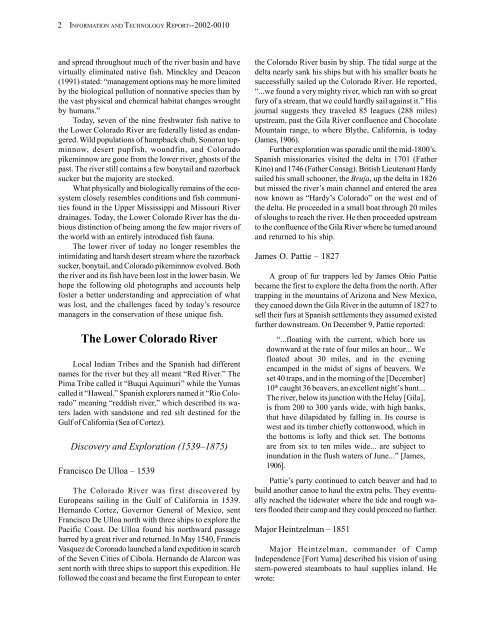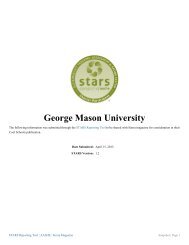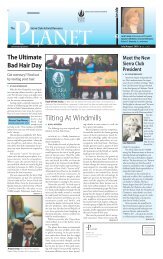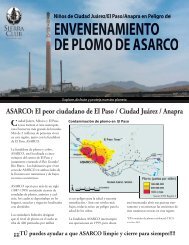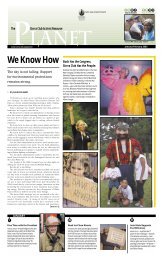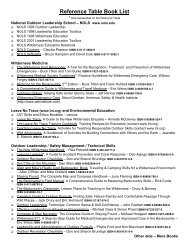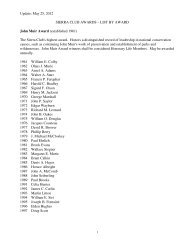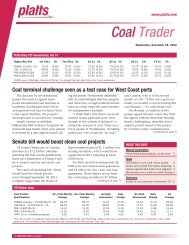Lost, A Desert River and its Native Fishes - Sierra Club
Lost, A Desert River and its Native Fishes - Sierra Club
Lost, A Desert River and its Native Fishes - Sierra Club
Create successful ePaper yourself
Turn your PDF publications into a flip-book with our unique Google optimized e-Paper software.
2 INFORMATION AND TECHNOLOGY REPORT--2002-0010<br />
<strong>and</strong> spread throughout much of the river basin <strong>and</strong> have<br />
virtually eliminated native fish. Minckley <strong>and</strong> Deacon<br />
(1991) stated: —management options may be more limited<br />
by the biological pollution of nonnative species than by<br />
the vast physical <strong>and</strong> chemical habitat changes wrought<br />
by humans.“<br />
Today, seven of the nine freshwater fish native to<br />
the Lower Colorado <strong>River</strong> are federally listed as endangered.<br />
Wild populations of humpback chub, Sonoran topminnow,<br />
desert pupfish, woundfin, <strong>and</strong> Colorado<br />
pikeminnow are gone from the lower river, ghosts of the<br />
past. The river still contains a few bonytail <strong>and</strong> razorback<br />
sucker but the majority are stocked.<br />
What physically <strong>and</strong> biologically remains of the ecosystem<br />
closely resembles conditions <strong>and</strong> fish communities<br />
found in the Upper Mississippi <strong>and</strong> Missouri <strong>River</strong><br />
drainages. Today, the Lower Colorado <strong>River</strong> has the dubious<br />
distinction of being among the few major rivers of<br />
the world with an entirely introduced fish fauna.<br />
The lower river of today no longer resembles the<br />
intimidating <strong>and</strong> harsh desert stream where the razorback<br />
sucker, bonytail, <strong>and</strong> Colorado pikeminnow evolved. Both<br />
the river <strong>and</strong> <strong>its</strong> fish have been lost in the lower basin. We<br />
hope the following old photographs <strong>and</strong> accounts help<br />
foster a better underst<strong>and</strong>ing <strong>and</strong> appreciation of what<br />
was lost, <strong>and</strong> the challenges faced by today‘s resource<br />
managers in the conservation of these unique fish.<br />
The Lower Colorado <strong>River</strong><br />
Local Indian Tribes <strong>and</strong> the Spanish had different<br />
names for the river but they all meant —Red <strong>River</strong>.“ The<br />
Pima Tribe called it —Buqui Aquimuri“ while the Yumas<br />
called it —Haweal.“ Spanish explorers named it —Rio Colorado“<br />
meaning —reddish river,“ which described <strong>its</strong> waters<br />
laden with s<strong>and</strong>stone <strong>and</strong> red silt destined for the<br />
Gulf of California (Sea of Cortez).<br />
Discovery <strong>and</strong> Exploration (1539œ1875)<br />
Francisco De Ulloa œ 1539<br />
The Colorado <strong>River</strong> was first discovered by<br />
Europeans sailing in the Gulf of California in 1539.<br />
Hern<strong>and</strong>o Cortez, Governor General of Mexico, sent<br />
Francisco De Ulloa north with three ships to explore the<br />
Pacific Coast. De Ulloa found his northward passage<br />
barred by a great river <strong>and</strong> returned. In May 1540, Francis<br />
Vasquez de Coronado launched a l<strong>and</strong> expedition in search<br />
of the Seven Cities of Cibola. Hern<strong>and</strong>o de Alarcon was<br />
sent north with three ships to support this expedition. He<br />
followed the coast <strong>and</strong> became the first European to enter<br />
the Colorado <strong>River</strong> basin by ship. The tidal surge at the<br />
delta nearly sank his ships but with his smaller boats he<br />
successfully sailed up the Colorado <strong>River</strong>. He reported,<br />
—...we found a very mighty river, which ran with so great<br />
fury of a stream, that we could hardly sail against it.“ His<br />
journal suggests they traveled 85 leagues (288 miles)<br />
upstream, past the Gila <strong>River</strong> confluence <strong>and</strong> Chocolate<br />
Mountain range, to where Blythe, California, is today<br />
(James, 1906).<br />
Further exploration was sporadic until the mid-1800‘s.<br />
Spanish missionaries visited the delta in 1701 (Father<br />
Kino) <strong>and</strong> 1746 (Father Consag). British Lieutenant Hardy<br />
sailed his small schooner, the Bruja, up the delta in 1826<br />
but missed the river‘s main channel <strong>and</strong> entered the area<br />
now known as —Hardy‘s Colorado“ on the west end of<br />
the delta. He proceeded in a small boat through 20 miles<br />
of sloughs to reach the river. He then proceeded upstream<br />
to the confluence of the Gila <strong>River</strong> where he turned around<br />
<strong>and</strong> returned to his ship.<br />
James O. Pattie œ 1827<br />
A group of fur trappers led by James Ohio Pattie<br />
became the first to explore the delta from the north. After<br />
trapping in the mountains of Arizona <strong>and</strong> New Mexico,<br />
they canoed down the Gila <strong>River</strong> in the autumn of 1827 to<br />
sell their furs at Spanish settlements they assumed existed<br />
further downstream. On December 9, Pattie reported:<br />
—...floating with the current, which bore us<br />
downward at the rate of four miles an hour... We<br />
floated about 30 miles, <strong>and</strong> in the evening<br />
encamped in the midst of signs of beavers. We<br />
set 40 traps, <strong>and</strong> in the morning of the [December]<br />
10 th caught 36 beavers, an excellent night‘s hunt...<br />
The river, below <strong>its</strong> junction with the Helay [Gila],<br />
is from 200 to 300 yards wide, with high banks,<br />
that have dilapidated by falling in. Its course is<br />
west <strong>and</strong> <strong>its</strong> timber chiefly cottonwood, which in<br />
the bottoms is lofty <strong>and</strong> thick set. The bottoms<br />
are from six to ten miles wide... are subject to<br />
inundation in the flush waters of June...“ [James,<br />
1906].<br />
Pattie‘s party continued to catch beaver <strong>and</strong> had to<br />
build another canoe to haul the extra pelts. They eventually<br />
reached the tidewater where the tide <strong>and</strong> rough waters<br />
flooded their camp <strong>and</strong> they could proceed no further.<br />
Major Heintzelman œ 1851<br />
Major Heintzelman, comm<strong>and</strong>er of Camp<br />
Independence [Fort Yuma] described his vision of using<br />
stern-powered steamboats to haul supplies inl<strong>and</strong>. He<br />
wrote:


